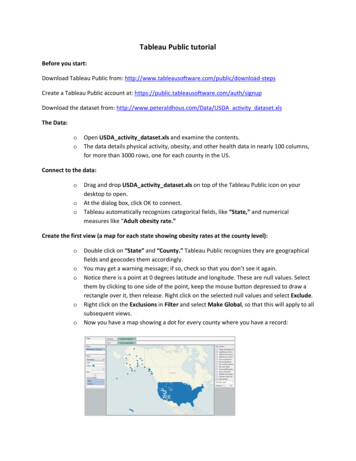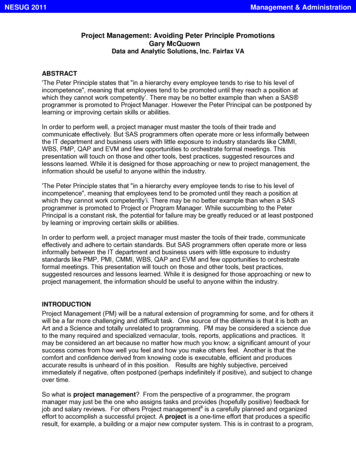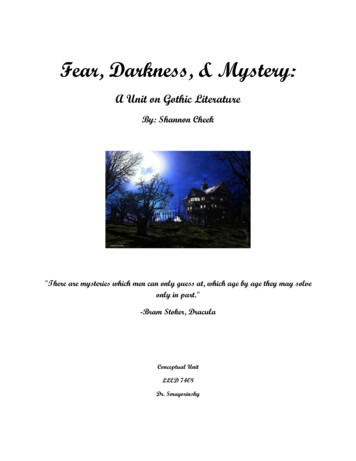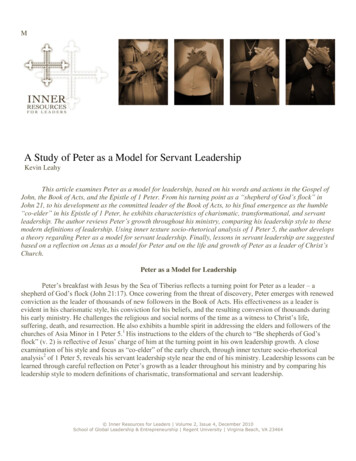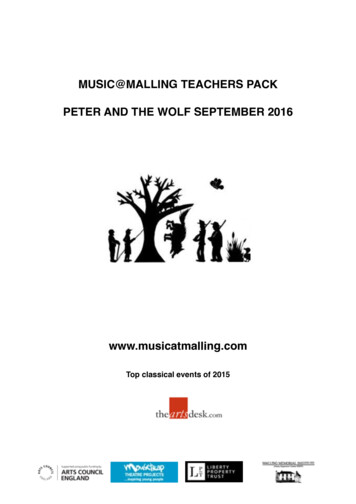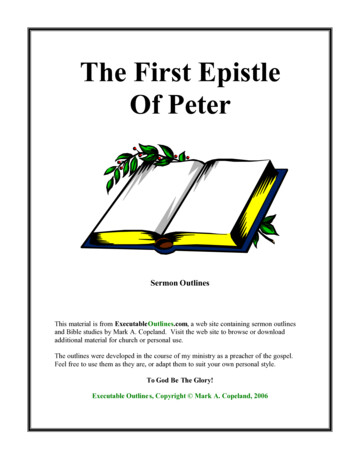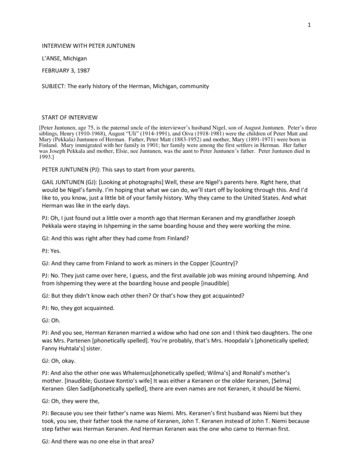
Transcription
1INTERVIEW WITH PETER JUNTUNENL’ANSE, MichiganFEBRUARY 3, 1987SUBJECT: The early history of the Herman, Michigan, communitySTART OF INTERVIEW[Peter Juntunen, age 75, is the paternal uncle of the interviewer’s husband Nigel, son of August Juntunen. Peter’s threesiblings, Henry (1910-1968), August “Uli” (1914-1991), and Oiva (1918-1981) were the children of Peter Matt andMary (Pekkala) Juntunen of Herman. Father, Peter Matt (1883-1952) and mother, Mary (1891-1971) were born inFinland. Mary immigrated with her family in 1901; her family were among the first settlers in Herman. Her fatherwas Joseph Pekkala and mother, Elsie, nee Juntunen, was the aunt to Peter Juntunen’s father. Peter Juntunen died in1993.]PETER JUNTUNEN (PJ): This says to start from your parents.GAIL JUNTUNEN (GJ): [Looking at photographs] Well, these are Nigel’s parents here. Right here, thatwould be Nigel’s family. I’m hoping that what we can do, we’ll start off by looking through this. And I’dlike to, you know, just a little bit of your family history. Why they came to the United States. And whatHerman was like in the early days.PJ: Oh, I just found out a little over a month ago that Herman Keranen and my grandfather JosephPekkala were staying in Ishpeming in the same boarding house and they were working the mine.GJ: And this was right after they had come from Finland?PJ: Yes.GJ: And they came from Finland to work as miners in the Copper [Country]?PJ: No. They just came over here, I guess, and the first available job was mining around Ishpeming. Andfrom Ishpeming they were at the boarding house and people [inaudible]GJ: But they didn’t know each other then? Or that’s how they got acquainted?PJ: No, they got acquainted.GJ: Oh.PJ: And you see, Herman Keranen married a widow who had one son and I think two daughters. The onewas Mrs. Partenen [phonetically spelled]. You’re probably, that’s Mrs. Hoopdala’s [phonetically spelled;Fanny Huhtala’s] sister.GJ: Oh, okay.PJ: And also the other one was Whalemus[phonetically spelled; Wilma’s] and Ronald’s mother’smother. [Inaudible; Gustave Kontio’s wife] It was either a Keranen or the older Keranen, [Selma]Keranen Glen Sadi[phonetically spelled], there are even names are not Keranen, it should be Niemi.GJ: Oh, they were the,PJ: Because you see their father’s name was Niemi. Mrs. Keranen’s first husband was Niemi but theytook, you see, their father took the name of Keranen, John T. Keranen instead of John T. Niemi becausestep father was Herman Keranen. And Herman Keranen was the one who came to Herman first.GJ: And there was no one else in that area?
2PJ: No. No permanent residents. There might have been some hunters or trappers or a thing like that,but there were no other families who had planned on establishing a home. There were some peoplewho were just working around there, like some who had been working on the railroad. There weresection houses about every three miles that were set up. Those were the only ones, there were noresidents in the Herman proper. There was section housing in L’Anse. There was a section housing inTaylor, no, from L’Anse the first section house was just about Beaubean[phonetically spelled; Bovine] inTaylor. Then the next section house was a mile north of Herp[phonetically spelled; Herman] Where myuncle Charlie was one of the section foreman.GJ: Charlie who?PJ: Dantes.GJ: Oh, okay.PJ: Aunt Annie’s husband. Let’s see, there was a section in Herman. Then there was another section inSummit.GJ: And it kept going all around?PJ: Because they were only about three, four miles apart. They had section houses, so, close together.GJ: So Herman [Keranen] came in and established a homestead.PJ: And then they started applying for mail. So they somehow or another somebody decided this wasHerman’s Siding. Because you see there was a Herman Siding where they had these places where theyswitched empty logging cars where they loaded logs and all kinds of firewood and anything like that andcalled it Herman's Siding. So it became, [also reported to have considered placename as Nels’ Siding,after Nels Majhannu, but settled on Herman, 1902]GJ: Because it was Herman’s, that was where Herman was?PJ: Yeah. And that was Herman Keranen was the first name.GJ: How long did it take before others began moving into the area, then?PJ: Almost immediately because during the first, there was Herman Keranen and Joseph Pekkala, andKusti [Gusti or Gustave], G-U-S-T, K-O-N-T-I-O were thefirst three families. GJ: Who was the second one?PJ: Second one was Joseph.GJ: Oh, okay, Joseph Pekkala. And that is your-?PJ: My mother’s dad. And I think they came the family came, Mrs. Pekkala because I was they musthave come in 1901. Or 1900. I don’t remember for sure. Because some of the figures that we had as towhen they came from Finland, they don’t jive. Because Fanni Huhtala and August Pekkala were born in1901. The first year. As far I know.GJ: So,PJ: Because Danny [Fanny] says she was eleven years old when Iwas born. GJ: Oh, okay.PJ: And she was the one who helped me get a passport.
3GJ: You were explaining on the phone. Because they didn’t have records?PJ: Because there was no birth record in the county. Because the county clerk’s office never wrote themdown. The treasurer’s office showed that my grandmother had received a payment for reporting thebirth. No record was made at the county clerk’s office. There were several hundred in the county whosebirth records were 1911, ’12, and ’13, but I was [inaudible]GJ: Had they been recorded before that time? They were after that time, but not-?PJ: Not during those few years.GJ: That made it difficult.PJ: You see, in those days there was no hospital, so all the births were taken care of by midwives.GJ: At home? And then supposedly the parents had to go and register,PJ: And sometimes, and in those days the doctors made house calls. The doctor who came to Hermanoriginally came from Michigamme. Most of the time from Michigamme.GJ: You traveled daily? Not daily.PJ: You see, Herman had six passenger trains a day.GJ: Ah, all in a day. So how long of a trip would it have been from Michigamme to Herman?PJ: It was about a little and [over] half an hour. Because it was only about eighteen miles. Along therailroad tracks.GJ: So that would have been a tremendous trip? In fact that was a major transport wasn’t it, for thattime?PJ: All transportGJ: Didn’t people have any horse and buggy out?PJ: Yeah, they had horse and buggy.GJ: Although in the winter, now that would be another story, wouldn’t it?PJ: You see like traveling from Herman to L’Anse was only eighteen cents.GJ: Wow.PJ: Was the fare.GJ: Now when was that?PJ: Oh, that was until in the late ‘30s, early ‘40s.GJ: So that was really a reasonable rate?PJ: [Inaudible] to Marquette was less than a dollar.GJ: Did people travel a lot by the railroad?PJ: Oh, sure.
4GJ: It wasn’t like you stayed all winter long at home?PJ: We had before. One family who came there, who came from Bessemer, a man came with his wifeand two sons, two young sons. Twice before World War I and once after World War I and it was just alittle over a year ago when we first met any member of the family. The young son Gilbert came here toBaraga and my brother found him at the state park when he was registering the tourists. And this man,[inaudible] his name was Gilbert [inaudible; Juntunen] he came from Bessemer. He came here for theengineer’s fortieth reunion.GJ: Was he a relative?PJ: And he looked at my brother and he said ‘gosh tootin,’ and he was telling my brother that his parentsand his two older brothers had talked many times about coming on the train from Bessemer to Hermanto visit some relatives. And he told Willy [Uli] that must be [inaudible] Well, my brother told him if hecameto Herman to visit relatives, he has to be a relative because we were the only Juntunen family there.GJ: When did the Juntunen’s come to Herman then?PJ: My dad came in 1903. So he married mother in 1909.GJ: Okay, so her family was already established in Herman in 1800s [correction, 1901], did he comeas a logger, or what was his occupation?PJ: No, you see, my dad had no relatives except cousins already in the Pekkala family. My dad andmother were first cousins.GJ: Okay. And he came up to Herman to be near what family he had? And then married his cousin?PJ: Yeah. And you see he had an uncle in North Laird near Alston. He spent one winter there. And thisuncle, who was an august gentleman, his wife was Charlie Dantes’ sister, who married mother’s oldestsister. See how it’s mixed up?GJ: Well, I get the sense from the Herman community of some time back that everybody eventually wasrelated to everybody else.PJ: Yes, by marriage or some other way.GJ: So those families that are still there that were from the original families are still somewhat-?PJ: There’s not too many of those left, you know. Most of them died and moved away, some have found[inaudible] copper near Herman and they wouldn’t sell it because they were going to retire. Most ofthem died before they were retired.GJ: And then a lot of young people from away have started moving in?PJ: Herman would be a bigger community if there was property available close by. For people withfamilies, kids, it’s just as good a place to live in than in a big city. Because the school buses, are, the snowplow comes every morning, no problem getting into town except for backed up roads.GJ: What about when you were a kid. Now, were there did you go to L’Anse on the railroad exclusivelyor were there roads?PJ: Oh yes, there was a road. You see, U.S. 41 came on through Herman. The original road.GJ: Now I know near the big hill is,
5PJ: Went through Herman. That originally was 41. It wasn’t until the ‘20s, early ‘20s that they startedmaking U.S. 41 by way of Alberta,GJ: Why did they change it?PJ: Because they wanted a better road toward Huntington [Covington],for example.GJ: And that was too much out of the way?PJ: Yep. And there were plenty of big hills and like that.GJ: Well, when you were kids did you stay pretty much in the Herman area where everything was withinthe community there, where like now everybody comes to L’Anse?PJ: Well, in Herman the first co-op effort in Herman was a flour mill.GJ: Okay, the historical society has-,PJ: And that building now is what used to be the post office. Right there at the four corners. That wasthe post office building before flour mill. It was moved about three hundred feet, it was near therailroad. It was right next to the railroad track. So that they could even send out feed and they could getcorn or grain by train, and if they had a lot of wheeling to do they could ship it out by railroad cars. Theflour mill was right next to the railroad. And they had a big gasoline engine. That had only two frontwheels, metal, and the rear wheel was two feet wide, or two and half feet wide, course in the middleunderneath Was the only tractor of that type I have ever seen. And it was, it had enough power tooperate the entire flour mill. And it would make just as white as you could buy from, you know, theother place they had a flour mill like this ever around here was in Houghton. Houghton had a flour millthat was in operation until a few years ago.GJ: Was it a successful mill?PJ: Well, there wasn’t enough work for it. So, people,GJ: Would they grow the grain in the Herman area?PJ: Herman area, yep. You could grow winter wheat. Winter wheat was actually more successful thanspring wheat. Winter wheat and winter rye grew in the bog. And when the snow would melt it wouldmature earlier than barley. You see a lot of people grew barley. Barley matured earlier than oats. Butthey kept on, they had an experimental farm in Chad [Chatham] where they developed these earliermaturing wheat and barley and oats and things like that. Cross bred them or pollinated.GJ: Well where the Keranens and the Pekkala, and is it the Kontio family?PJ: Kontio means a bear.GJ: What did they originally start out as? As farmers?PJ: Nope. No, none of them ever had any idea that Herman would become a community. Because thesame at North Laird in Alston where my dad spent with his uncle, they were cutting virgin timber in theforest. That was in the days when hardwood, birch, maple, elm, and all these hardwoods were used toheat the boulders and [inaudible; iron] mines. And all the wood shops and factories. Because at that timecoal was not so easily available. They didn’t have these ore boats until after, they were around after1900. So virgin timber forests were cut for the firewood. And that was like at Mallard [?], my dad’s uncle,he homesteaded. Most of those were homesteads. And there was a narrow range railroad that wouldhaul
6all the firewood and the logs to Houghton Hancock. And some of the other timber was cut into lumberto [inaudible] the saw mills. And most of the hardwood, hardwood was not used for lumber at allbecause we had pine, and elm wood, and cedar, and that was easier to work with. You see, with ahammer you can put a nail through pine and a hemlock and a cedar log, with a birch and maple even ifthe wood is dry you have a hard time getting a nail through it.GJ: So those original homes up there are made out of what kind of wood?PJ: Oh, the original homes were made out of pine. That was the building material because pine wasplentiful.GJ: Well now, my parents were here, and that was the [inaudible] farm.PJ: Most stories are these logs.GJ: Now is that how they constructed most of their houses?PJ: The Keranen’s farm. They farmed a big house where Dr. Lansing’s [Lanczy’s] daughter lives now. Theoriginal part was logs. Then 3/4s of the house that is running this way is [inaudible; gesturing] a lot ofhouses were [inaudible; built like that] and you see where I was born was on the Firetower Hill wheregrandpa made the log house. Then they added from lumber a frame addition [inaudible].GJ: But it is right now as it was then?PJ; No, that was torn down. My uncle tore it down
uncle Charlie was one of the section foreman. GJ: Charlie who? PJ: Dantes. GJ: Oh, okay. PJ: Aunt Annie’s husband. Let’s see, there was a section in Herman. Then there was another section in Summit. GJ: And it kept going all around? PJ: Because they were only about three, four miles apart. They had section houses, so, close together. GJ: So Herman [Keranen] came in and established a .
